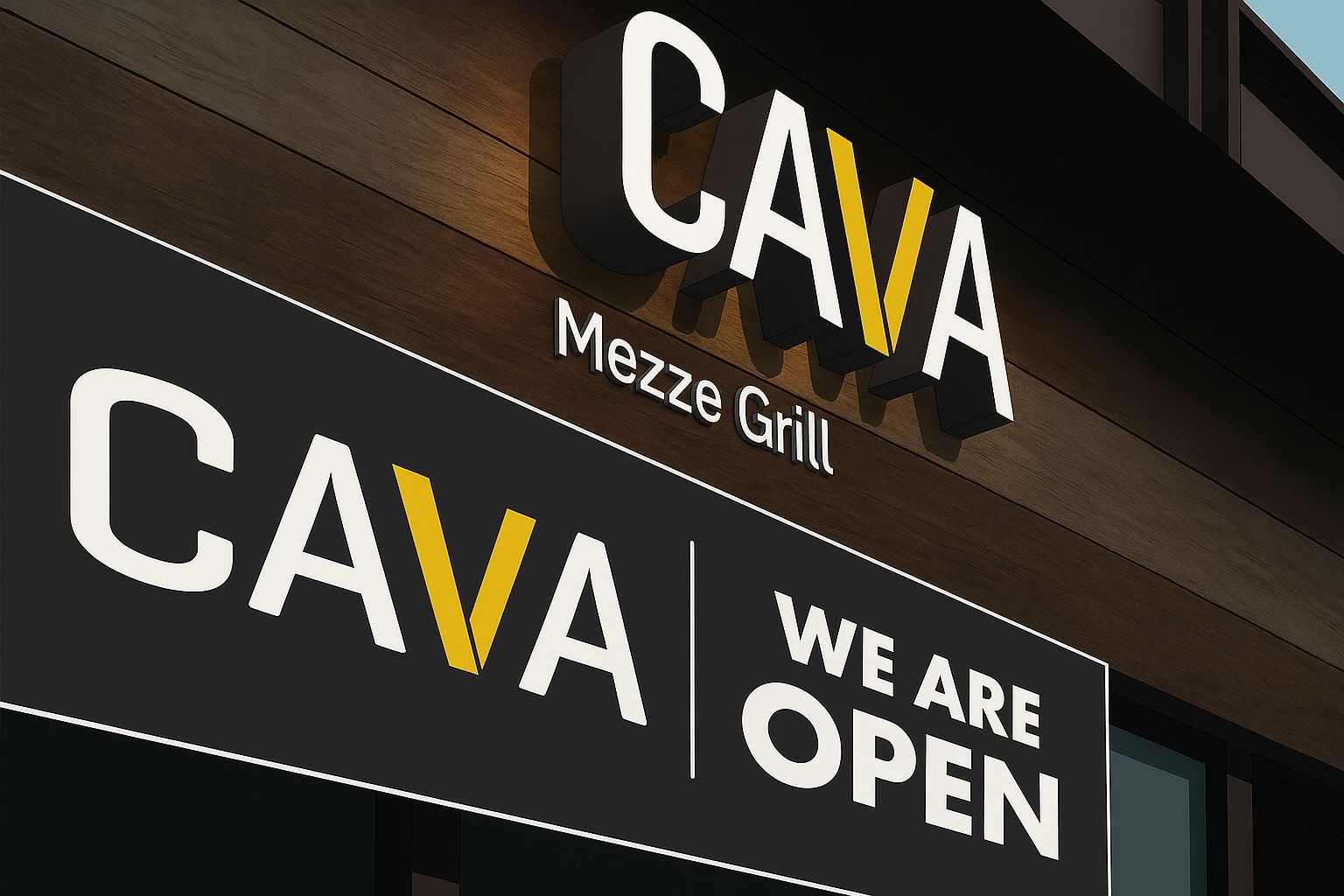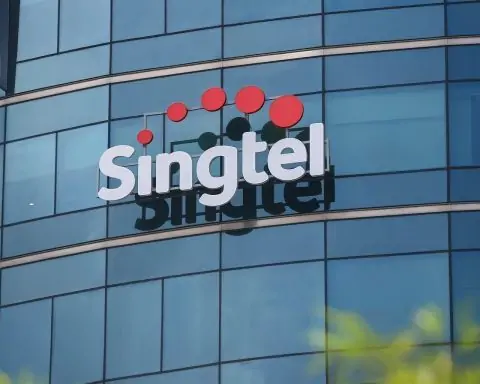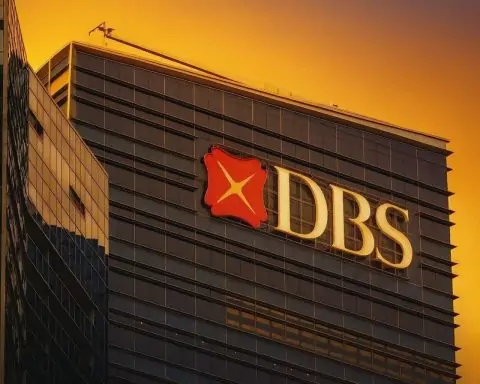- Ticker: CAVA (NYSE), market cap ~$6.0B [1]. ~116 million shares outstanding [2].
- Price (Nov 4, 2025): ≈$51.7 (at close) [3]. Range in past year: $51.3–$172.4 [4].
- Recent performance: Down ~15% in the past week (steepest weekly drop since August) [5]. Year-to-date decline ~52–60% [6] [7].
- 52-week: –60% [8]. High volatility (beta ~2.5) [9].
- Earnings (Q3 2025): Revenue $289.8M (+20% YoY) [10]; same-store sales +1.9% [11]; net income $14.7M (5.0% margin) [12]; Adjusted EBITDA $40.0M [13]. Opened 17 net new restaurants (total 415, +17.9% YoY) [14].
- Guidance: Full-year same-store sales growth trimmed to 3–4% (from 4–6%) and restaurant-margin guidance lowered [15].
- Valuation: Very rich – trailing P/E ≈44x, forward P/E ≈87x [16]; forward P/S ~4.6× [17]. Stock trades at a premium to peers.
- Analysts: Mixed opinions. Consensus rating ~“Moderate Buy” or “Neutral” [18] [19], average 12-month target $80–90 (roughly 50–70% above current) [20]. (Targets range from about $61 to $120) [21].
- Sentiment: Retail investors turned “extremely bullish” ahead of Q3 earnings [22], despite share weakness. Short interest is high (~12% of float) [23], and insiders have only sold recently (CEO sold ~32k shares in past 6 months) [24].
- Ownership: About 74% held by institutions [25] (many big funds, but >$2.4B institutional outflows last 12 months [26]).
Stock Price & Recent Performance
Cava’s stock has fallen sharply in 2025. After peaking near $172 in late 2024, it traded around $51.7 at the Nov. 4, 2025 close [27]. That marks a roughly 60% drop from its high and a ~52% decline year-to-date [28] [29]. In late October, the stock plunged (~11% on Oct 30 alone) when rival Chipotle trimmed its outlook [30], and it fell another ~2–3% at the start of November. In fact, one trading report notes a 15.5% slide “last week” (week ending Nov. 1) – the steepest since August [31]. Overall, CAVA has significantly underperformed the broader market and even its own category peers this year.
In the past five trading days, CAVA has been mixed: after an Oct 31 uptick (closing ~$53.7), the stock eased back to the low-$52s by Nov 3 [32]. Intraday Nov 4 it traded roughly $51–53 range (low $51.62, high $53.76 [33]), closing slightly lower. Trading volume has been above average, reflecting volatility. By comparison, fellow “fast-casual” stocks have also struggled: Chipotle and Sweetgreen shares fell on Oct. 30, and Business Insider notes “shares of competitors Cava Group and Sweetgreen fell as much as 8% and 6%, respectively” after Chipotle’s warning [34]. In short, CAVA’s recent price action reflects both company-specific factors and sector-wide fears about consumer spending (especially from younger diners).
Recent News & Developments
Earnings (Q3 2025): On Nov. 4 (after market close), Cava reported third-quarter results. The company delivered solid topline growth (20.0% to $289.8M) [35], driven by new openings (17 net adds) and a slight menu-driven sales increase (+1.9% same-restaurant sales) [36]. CEO Brett Schulman emphasized that the quarter “delivered another quarter of market share growth” and pointed to the performance of new units (2025 cohort with ~$3M average unit volumes) as “clear proof of the brand’s portability” [37]. At the restaurant level, profit margin was 24.6% (vs 25.6% a year ago) [38]. Net income rose to $14.7M (5.0% of revenue) [39], though that was slightly below last year’s $18.0M due to higher costs (food inflation, wages, delivery mix). Adjusted EBITDA grew ~20% to $40.0M [40].
However, the company also trimmed full-year guidance on the Nov. 4 call. It lowered its same-store sales growth outlook to 3–4% (from a prior 4–6%) and reduced restaurant-level profit margin guidance to ~24.4–24.8% (from 24.8–25.2%) [41]. Pre-opening expenses and EBITDA outlook were modestly cut as well [42]. These revisions reflect continued macro headwinds: inflation (tariffs, chicken shawarma launch costs) and wage pressure are eroding some profitability.
Industry Context: Late Oct 2025 saw a broader “fast casual” shock. Chipotle’s Q3 (Sept) results on Oct. 29 showed only +0.3% comp-sales growth, and management cut its full-year comps outlook for the third quarter in a row [43]. Chipotle’s stock plunged (~18%) and sent ripples through the industry. As noted by Business Insider, the sour Chipotle forecast dragged down similar chains: “Shares of competitors Cava Group and Sweetgreen fell as much as 8% and 6%, respectively.” [44]. The theme was that younger diners are tightening budgets for restaurant “burritos and salad bowls.” Similarly, analyst reports and media questioned whether higher menu prices at Cava could deter price-sensitive customers.
Other Developments: Cava continues to expand and innovate. Recent press releases highlight menu and loyalty initiatives: for example, a partnership with gamer Clix and an upgraded rewards program [45] [46]. The chain also opened new markets (first Miami store in Oct 2025 [47]) and announced loyalty perks. These efforts aim to boost traffic and customer engagement.
Meanwhile, analyst and investor chatter intensified. On Stocktwits, retail sentiment flipped from bearish to “extremely bullish” ahead of the Nov. 4 earnings release [48], even as pro analysts pared targets. For instance, Bank of America, Morgan Stanley and Goldman lowered their CAVA price targets in early November [49]. According to Stocktwits news, 12 of 21 analysts still rate CAVA at Buy or higher (9 rate Hold) with an average target of ~$83.56 (implying ~56% upside) [50]. In sum, recent weeks have seen a tug-of-war between positive growth metrics and caution over valuation and spending trends.
Earnings & Growth Outlook
Cava’s last reported quarter (Q3 2025) showed strong growth but modest profit pressure. Revenue jumped 20% Y/Y [51], far outpacing the low-single-digit comps. CEO Schulman underscored that strategy (new markets in Michigan, Pittsburgh; menu innovation) and brand positioning (healthful Mediterranean) support continued expansion [52] [53]. In fact, Zacks noted that Cava’s unique Mediterranean niche and lack of scaled competitors give it “a clear advantage as the category’s dominant leader with no scaled competition” [54]. Menu rollouts (e.g. chicken shawarma) and digital/tech upgrades (kitchen display, AI order tracking) should keep driving traffic, according to one preview report [55].
However, analysts see risks. Cava’s recent earnings beats have been impressive (by ~25% on average), but rising costs and price-sensitive consumers could weigh on margins. Zacks’ model actually ranks CAVA as a “Sell” ahead of Q3, since historical beats seem priced in [56]. Indeed, the Q3 press release revealed margins dipped as delivery mix rose and food/labor costs climbed [57]. Management’s guidance cut confirms this uncertainty. Over the long run, Cava expects to sustain mid-single-digit comps growth as it scales, but near-term volatility is likely given economic headwinds [58].
Market Position: Cava is still early in its growth story compared to giants like Chipotle. As of Q3, Cava had 415 total stores (company-owned) vs Chipotle’s ~3,000. A Restaurant Dive analysis emphasizes Cava’s “clear segment leader” status in Mediterranean fast-casual [59], but notes the market is “far from mature” with many regional brands trying to catch up. TD Bank franchise expert Mark Wasilefsky predicts the Mediterranean fast-food segment will grow as more consumers seek healthy options, but warns smaller chains are vulnerable once Cava or other big players enter nearby locations [60]. In short, Cava dominates its niche today, but competition (Sweetgreen, local Mediterranean concepts like Taim/Taziki’s, etc.) is intensifying. Chipotle’s size and financial strength dwarf Cava’s, but both share a similar customer base; underperformance at Chipotle has amplified concerns for Cava.
Valuation, Sentiment & Ownership
Cava’s valuation metrics are extremely rich. The trailing P/E is roughly 44× earnings, and the forward P/E is about 87× [61] – far above the industry average. Its price-to-sales (~4.6×) is higher than most peers [62]. For context, analysts note Cava “carries a premium compared with its industry on a forward P/S basis” [63]. The company’s PEG ratio (~2.8) and EV/EBITDA (~50× [64]) also suggest stretched expectations. In short, the stock price seems to reflect ambitious growth forecasts, not the modest current earnings.
Investor sentiment is divided. Institutional ownership is high (~74%) [65], meaning major funds have bought in – yet institutions have also been net sellers (over $2.4B of outflows this year [66]). Hedge funds have shifted positions: thousands added shares last quarter (indicating some optimism) [67] even as some large holders pared stakes (Jennison Associates cut ~6.4M shares in Q3) [68]. Social sentiment is mixed: TipRanks notes “very negative” crowd sentiment recently [69], reflecting hedge funds and retail booking profits. Short interest is high (~11.5% of float [70]), so a lot of investors are betting on a further drop. At the same time, some bullish momentum exists – Stocktwits reported a surge in retail bullishness ahead of earnings [71].
Inside the company, all the recent stock moves have been sales – no insider buying. CEO Brett Schulman and other executives sold shares over the past months (Schulman offloaded ~32,000 shares worth $2.4M in one trade [72]). Insider selling can be a concern, though it may partly reflect personal financial planning or liquidity needs.
Analysts & Forecasts
Wall Street is split. Different firms have very different price targets. StockAnalysis (Nov 4) reports 16 analysts covering CAVA with an average target of $89.50 (about +73% upside) [73]. That range is wide – lowest $61, highest $120 [74]. QuiverQuant lists the same spread: UBS at $61 (Nov. 3) vs Stifel at $100 (Oct. 31), Morgan Stanley ~$95, Barclays $64, etc. [75]. TipRanks pegs the consensus “Moderate Buy” with ~$82.64 avg target (≈57% upside) [76], in line with Benzinga’s $85.5 [77]. Notably, some top analysts are cautious: Zacks gives CAVA a Rank 4 (Sell) in its system [78], and firms like CFRA and Bernstein recently lowered targets to $120 and $100 (respectively) warning of slowing sales [79].
On the bullish side, RBC Capital initiated Cava at Outperform in early Oct with an $80 target [80], arguing that the massive pullback makes Cava “an opportunity” given its unit economics and $290M cash/no-debt balance [81] [82]. RBC projects a huge addressable market (~2,429 US units, ~6× current size) [83]. Jefferies (Oct 2025) reiterated Buy, calling the recent selloff a “buying opportunity” and expecting comps to rebound by 2026 [84]. KeyBanc and others previously had higher targets ($95–115) but have tempered expectations after midyear guidance cuts.
Expert quotes: Financial commentator Jim Cramer has been skeptical of Cava’s premium prices. He told TV viewers Cava “is not cheap – it just costs too much for a dinner for a family of five” [85]. Others in the industry offer a more nuanced view: TD Bank’s Mark Wasilefsky notes that while Cava leads a growing Mediterranean segment, “opportunities for these regional players” exist until a big player (like Cava) enters their market [86].
Summary Insight
Cava sits at a crossroads. On one hand, its recent quarter showed double-digit growth, continued expansion, and a strong balance sheet – all signs of a scaling fast-casual brand [87] [88]. On the other hand, Cava’s stock has collapsed amid a general slowdown in restaurant traffic and questions about its lofty valuation. Analysts and investors are weighing fundamentals versus expectations. Some view the pullback as a buying opportunity given Cava’s long runway [89], while others worry that consumer fatigue and high prices could limit growth.
For the general investor, the headline issue is valuation and sentiment. Cava’s growth rate (20% revenue jump) is impressive, but the stock’s high P/E and rich multiples mean any slip in momentum could hurt the share price. The near-term outlook hinges on whether Cava can weather the same consumer pressures that hit Chipotle and Sweetgreen. Key events to watch: the upcoming Q4 trends, same-store sales comps, and how aggressively management can control costs. Institutions largely own Cava, suggesting confidence, but the high short interest indicates many professionals are betting on further weakness [90].
Bottom line: CAVA stock remains controversial. If you believe in the long-term Mediterranean fast-casual trend and Cava’s leadership, the recent downturn may look like a chance to buy. If you’re skeptical of current multiples or concerned about economic headwinds, caution is warranted – as even CEO Schulman now warns, growth may come with margin volatility in the short run [91] [92].
Sources: CAVA’s Q3 2025 earnings release [93] [94]; industry news [95] [96] [97]; analyst reports [98] [99] [100]; stock data and forecasts [101] [102] [103]. All figures are as of Nov 4, 2025.
References
1. stockanalysis.com, 2. stockanalysis.com, 3. stockanalysis.com, 4. stockanalysis.com, 5. stocktwits.com, 6. stocktwits.com, 7. stockanalysis.com, 8. stockanalysis.com, 9. stockanalysis.com, 10. www.businesswire.com, 11. www.businesswire.com, 12. www.businesswire.com, 13. www.businesswire.com, 14. www.businesswire.com, 15. www.businesswire.com, 16. stockanalysis.com, 17. www.nasdaq.com, 18. www.benzinga.com, 19. stockanalysis.com, 20. stockanalysis.com, 21. stockanalysis.com, 22. stocktwits.com, 23. stockanalysis.com, 24. www.quiverquant.com, 25. stockanalysis.com, 26. www.marketbeat.com, 27. stockanalysis.com, 28. stockanalysis.com, 29. stocktwits.com, 30. www.businessinsider.com, 31. stocktwits.com, 32. stockanalysis.com, 33. stockanalysis.com, 34. www.businessinsider.com, 35. www.businesswire.com, 36. www.businesswire.com, 37. www.businesswire.com, 38. www.businesswire.com, 39. www.businesswire.com, 40. www.businesswire.com, 41. www.businesswire.com, 42. www.businesswire.com, 43. www.businessinsider.com, 44. www.businessinsider.com, 45. stockanalysis.com, 46. stockanalysis.com, 47. stockanalysis.com, 48. stocktwits.com, 49. stocktwits.com, 50. stocktwits.com, 51. www.businesswire.com, 52. www.businesswire.com, 53. www.nasdaq.com, 54. www.nasdaq.com, 55. www.nasdaq.com, 56. www.nasdaq.com, 57. www.businesswire.com, 58. www.investing.com, 59. www.restaurantdive.com, 60. www.restaurantdive.com, 61. stockanalysis.com, 62. www.nasdaq.com, 63. www.nasdaq.com, 64. stockanalysis.com, 65. stockanalysis.com, 66. www.marketbeat.com, 67. www.quiverquant.com, 68. www.quiverquant.com, 69. www.tipranks.com, 70. stockanalysis.com, 71. stocktwits.com, 72. www.quiverquant.com, 73. stockanalysis.com, 74. stockanalysis.com, 75. www.quiverquant.com, 76. www.tipranks.com, 77. www.benzinga.com, 78. www.nasdaq.com, 79. www.investing.com, 80. www.investing.com, 81. www.investing.com, 82. www.investing.com, 83. www.investing.com, 84. www.investing.com, 85. www.insidermonkey.com, 86. www.restaurantdive.com, 87. www.businesswire.com, 88. www.investing.com, 89. www.investing.com, 90. stockanalysis.com, 91. www.businesswire.com, 92. www.investing.com, 93. www.businesswire.com, 94. www.businesswire.com, 95. www.businessinsider.com, 96. stocktwits.com, 97. stocktwits.com, 98. www.nasdaq.com, 99. www.benzinga.com, 100. www.investing.com, 101. stockanalysis.com, 102. stockanalysis.com, 103. stockanalysis.com










